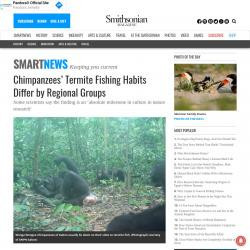
Morphology of the gastrointestinal tract in primates: Comparisons with other mammals in relation to diet. American Journal of Physical Anthropology 117, 349–363.Ĭhivers, D.J., Hladik, C.M., 1980. Scale issues in the study of primate foraging: Red colobus of Kibale National Park. Digesta retention in the gastro-intestinal tract of the orangutan ( Pongo pygmaeus). Hunting and scavenging by Plio-Pleistocene hominids: Nutritional constraints, archaeological patterns, and behavioral implications. (Ed.), Evolution of the Human Diet: The Known, the Unknown, and the Unknowable. (Ed.), Ecological Implications of Minilivestock, Science Publishers, Plymouth, pp. Insects in the human diet: Nutritional aspects. Cambridge University Press, Cambridge, pp. (Eds.), Behavioral Diversity in Chimpanzees and Bonobos. In: Boesch, C., Hohmann, G., Marchant, L.F. Variation in chimpanzee-red colobus interactions. Behavioral Ecology and Evolution, Oxford University Press, Oxford.īoesch, C., Uehara, S., Ihobe, H., 2002. Tool use and tool making in wild chimpanzees. Possible causes of sex differences in the use of natural hammers by wild chimpanzees. Optimization of nutcracking with natural hammers by wild chimpanzees. Chimpanzees-red colobus monkeys: A predator-prey system. (Eds.), Colobine Monkeys: Their Ecology, Behavior, and Evolution. University of Chicago Press, Chicago, IL, pp. In: Smuts, B.B., Cheney, D.L., Seyfarth, R.M., Wrangham, R.W., Struhsaker, T.T. Lorises, bush babies, and tarsiers: Diverse societies in solitary foragers. American Journal of Primatology 58, 1–21.īearder, S.K., 1987. Diet composition of chimpanzees inhabiting the montane forest of Kahuzi, Democratic Republic of Congo. International Journal of Food Science and Technology 39, 223–229.īasabose, A.K., 2002.

Chemical composition, functional properties and baking potential of African breadfruit kernel and wheat flour blends. Patterns of food sharing by bonobos offer a model for how a change in the diet of adults could have precipitated to immatures. Instead, evidence suggests that food sharing and provisioning have developed in the context of frugivory when primates consume fruits that are large and/or difficult to process. Information from bonobos and chimpanzees suggest that neither food sharing nor provisioning is causally related to hunting and meat eating. In bonobos, adult females control access to carcasses and share meat among each other and with immatures. Patterns of meat sharing by chimpanzees and bonobos differ: in chimpanzees, the majority of the prey is consumed by adult males and adult females. In forest populations, hunting increases at times when plant food is highly abundant, suggesting that hunting activities are triggered by high energy intake from plant foods. Hunting and meat eating occurs equally in forests and in open habitats. Except for bonobos, insectivory is common among Pongids, and except for gorillas and orangutans, consumption of vertebrate meat is habitual. Consumption of animal food is widespread, but may vary considerably between species. Food may be transferred between mature individuals (e.g., chimpanzee, bonobo) or from mature individuals to immatures (e.g., bonobo). In some species, food sharing is habitual. The diets of Hominids ( Pan, Gorilla, and Pongo) are dominated by plant foods. Food processing is likely to affect food intake rate, passage time, and nutrient absorption.

Primates practice various forms of food processing and by doing so modify the physical structure of food. Food habits may also vary within and between groups of the same species for other reasons, such as inter-specific competition and local traditions. Patterns of food selection shift in relation to seasonal changes in food availability. Most nonhuman primates have a mixed diet that consists of a wide spectrum of plant foods and a relatively small spectrum of animal foods.


 0 kommentar(er)
0 kommentar(er)
